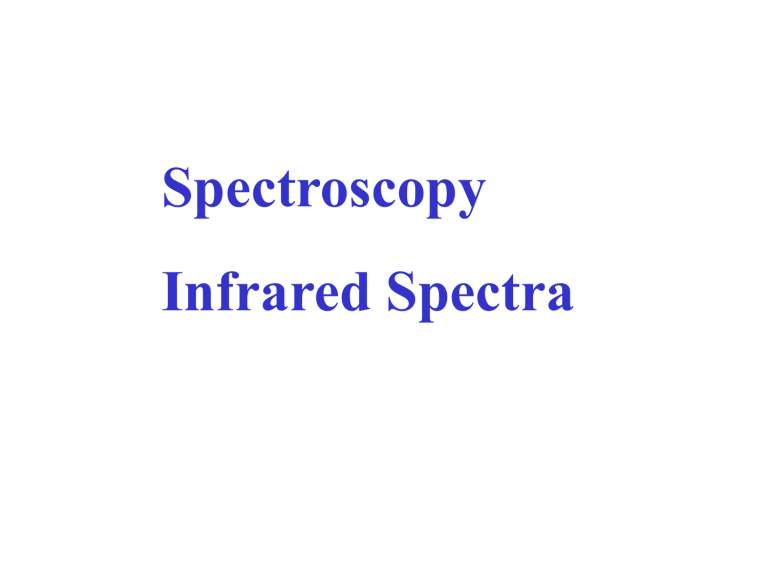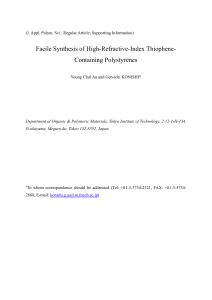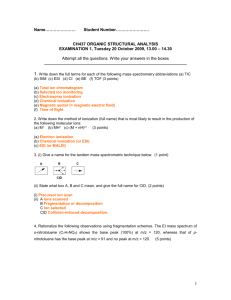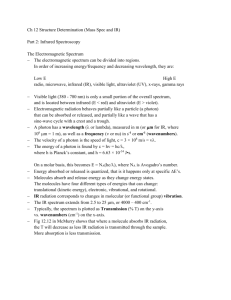Infrared Spectroscopy

Spectroscopy
Infrared Spectra
Infrared spectra in this presentation are taken by permission from the SDBS web site:
SDBSWeb: http://www.aist.go.jp/RIODB/SDBS/
?????????????????
Spectroscopy
“seeing the unseeable”
Using electromagnetic radiation as a probe to obtain information about atoms and molecules that are too small to see.
Electromagnetic radiation is propagated at the speed of light through a vacuum as an oscillating wave.
electromagnetic relationships:
λυ = c λ 1/υ
E = hυ
E = hc/λ
E
υ
E
1/λ
λ = wave length
υ = frequency c = speed of light
E = kinetic energy h = Planck’s constant c
λ
Two oscillators will strongly interact when their energies are equal.
E
1
= E
2
λ
1
= λ
2
υ
1
= υ
2
If the energies are different, they will not strongly interact!
We can use electromagnetic radiation to probe atoms and molecules to find what energies they contain.
some electromagnetic radiation ranges
Approx. freq. range
Hz (cycle/sec)
Radio waves 10 4 - 10 12
Infrared (heat) 10 11 - 3.8x10
14
Visible light
Ultraviolet
3.8x10
14 - 7.5x10
14
7.5x10
14 - 3x10 17
X rays
Gamma rays
3x10 17 - 3x10 19
> 3x10 19
Approx. wavelengths meters
3x10 4 - 3x10 -4
3x10 -3 - 8x10 -7
8x10 -7 - 4x10 -7
4x10 -7 - 10 -9
10 -9 - 10 -11
< 10 -11
Infrared radiation
λ = 2.5 to 17 μm
υ = 4000 to 600 cm -1
These frequencies match the frequencies of covalent bond stretching and bending vibrations. Infrared spectroscopy can be used to find out about covalent bonds in molecules.
IR is used to tell:
1. what type of bonds are present
2. some structural information
IR source
sample
prism
detector graph of % transmission vs.
frequency
=> IR spectrum
100
%T
0
4000 3000 2000 v (cm -1 )
1500 1000 500
toluene
BOND
C-H
O-H
C=C
C≡C
C-O
Some characteristic infrared absorption frequencies
COMPOUND TYPE alkanes alkenes
RCH=CH2
R2C=CH2
cis-RCH=CHR
trans-RCH=CHR aromatic rings monosubst.
ortho-disubst.
meta-disubst.
para-disubst.
alkynes alcohols or phenols alkenes aromatic rings alkynes primary alcohols secondary alcohols tertiary alcohols phenols alkyl ethers aryl ethers all abs. strong unless marked: m, moderate; v, variable; b, broad
FREQUENCY RANGE, cm -1
2850-2960 and 1350-1470
3020-3080 (m) and
910-920 and 990-1000
880-900
675-730 (v)
965-975
3000-3100 (m) and
690-710 and 730-770
735-770
690-710 and 750-810 (m)
810-840 (m)
3300
3200-3640 (b)
1640-1680 (v)
1500 and 1600 (v)
2100-2260 (v)
1050 (b)
1100 (b)
1150 (b)
1230 (b)
1060-1150
1200-1275(b) and 1020-1075 (m)
IR spectra of ALKANES
C—H bond “saturated”
(sp 3 ) 2850-2960 cm -1
+ 1350-1470 cm -1
-CH
2
-
-CH
3
-CH(CH
3
)
2
-C(CH
3
)
3
+ 1430-1470
+ “ and 1375
+ “ and 1370, 1385
+ “ and 1370(s), 1395 (m)
n-pentane
3000 cm -1
2850-2960 cm -1 sat’d C-H
1470 &1375 cm -1
CH
3
CH
2
CH
2
CH
2
CH
3
n-hexane
CH
3
CH
2
CH
2
CH
2
CH
2
CH
3
2-methylbutane (isopentane)
2,3dimethylbutane
cyclohexane no 1375 cm -1 no –CH
3
IR of ALKENES
=C—H bond, “unsaturated” vinyl
(sp 2 ) 3020-3080 cm -1
+ 675-1000
RCH=CH
2
+ 910-920 & 990-1000
R
2
C=CH
2
+ 880-900 cis -RCH=CHR + 675-730 (v) trans -RCH=CHR + 965-975
C=C bond 1640-1680 cm -1 (v)
unsat’d
C-H
3020-
3080 cm -1
1-decene
C=C 1640-1680
910-920 &
990-1000
RCH=CH
2
4-methyl-1-pentene
910-920 &
990-1000
RCH=CH
2
2-methyl-1-butene
880-900
R
2
C=CH
2
2,3-dimethyl-1-butene
880-900
R
2
C=CH
2
IR spectra BENZENE s
=C—H bond, “unsaturated” “aryl”
(sp 2 ) 3000-3100 cm -1
+ 690-840 mono-substituted + 690-710, 730-770 ortho -disubstituted + 735-770 meta -disubstituted + 690-710, 750-810(m) para -disubstituted + 810-840(m)
C=C bond 1500, 1600 cm -1
ethylbenzene
3000-
3100 cm -1
Unsat’d
C-H
1500 & 1600
Benzene ring
690-710,
730-770 mono-
o-xylene
735-770 ortho
p-xylene
810-840(m) para
m-xylene meta
690-710,
750-810(m)
styrene no sat’d C-H
1640
C=C
910-920 &
990-1000
RCH=CH
2 mono
2-phenylpropene
Sat’d C-H
880-900
R
2
C=CH
2 mono
p-methylstyrene para
IR spectra ALCOHOLS & ETHERS
C—O bond 1050-1275 (b) cm -1
1 o ROH 1050
2 o ROH
3 o ROH
1100
1150 ethers 1060-1150
O—H bond 3200-3640 (b)
1-butanol
3200-3640 (b) O-H
C-O 1 o
CH
3
CH
2
CH
2
CH
2
-OH
O-H
2-butanol
C-O 2 o
tert-butyl alcohol
O-H
C-O 3 o
no O--H methyl n-propyl ether
C-O ether
2-butanone
C=O
~1700 (s)
C
9
H
12
C-H unsat’d & sat’d
1500 & 1600 benzene
C
9
H
12
– C
6
H
5
= -C
3
H
7 mono isopropylbenzene
n-propylbenzene?
n-propylbenzene
isopropylbenzene isopropyl split 1370 + 1385
C
8
H
6
3300
C-H
C-H unsat’d
1500, 1600 benzene
C
8
H
6
– C
6
H
5
= C
2
H mono phenylacetylene
C
4
H
8
Unst’d
1640-
1680
C=C
880-900
R
2
C=CH
2 isobutylene CH
3
CH
3
C=CH
2
Which compound is this?
a) 2-pentanone b) 1-pentanol c) 1-bromopentane d) 2-methylpentane
1-pentanol
What is the compound?
a) 1-bromopentane b) 1-pentanol c) 2-pentanone d) 2-methylpentane
2-pentanone
In a “matching” problem, do not try to fully analyze each spectrum. Look for differences in the possible compounds that will show up in an infrared spectrum.
C
H
2
C C
H
CH
2 allylbenzene
E
H
2
C
H
2
C
1,2-diphenylethane
A biphenyl
B
CH
3
CH
3 o-xylene
D CH
3
CH
2
CH
2
CH
2
CH
3
F n -pentane
CH
2
CH
2 n -butylbenzene
CH
2
CH
3
1
2
3
4
5
6





